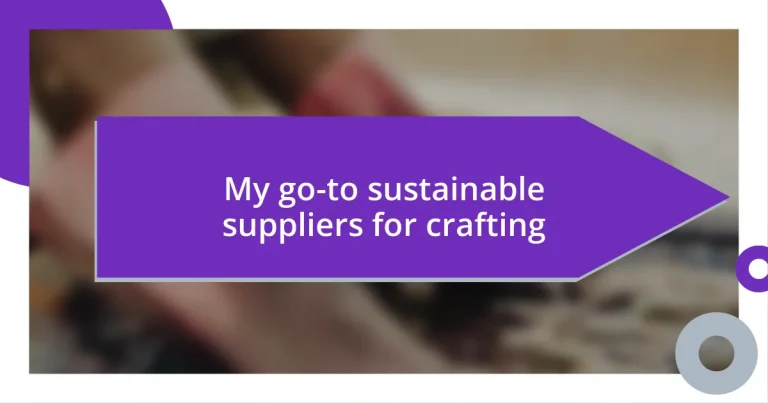Key takeaways:
- Awareness of the environmental impact of crafting choices led to a shift toward sustainable practices and materials.
- Key criteria for selecting ethical suppliers include transparency, fair labor practices, and commitment to sustainable materials.
- Researching the story behind products and engaging with suppliers enhances the crafting experience and fosters a connection to sustainability.

My crafting sustainability journey
As I embarked on my crafting sustainability journey, I remember the moment I first realized the impact of my choices. I was rummaging through my overflowing supply bins and felt a pang of guilt when I noticed the sheer amount of plastic packaging and conventional materials I had accumulated. Have you ever faced that moment of awakening where you just know things have to change?
With each project I completed, I began to ask myself: how could I create beautiful things without harming the planet? It was during a late-night crafting session, surrounded by vibrant scraps I had saved from my previous projects, that inspiration struck. I found joy in transforming what others might consider waste into stunning pieces of art—pieces that carried a story instead of being mere objects.
Over time, this journey shifted my perspective entirely. I started reaching out to local artisans and suppliers who prioritized eco-friendly practices, not just because it felt good, but because I genuinely wanted to support a community committed to sustainable crafting. This connection filled my heart with purpose, making each crafting session not just a pastime but a meaningful contribution to a larger movement. It’s incredible how a simple change in mindset can turn crafting into a powerful form of expression and responsibility.

Understanding sustainable materials
Understanding sustainable materials is paramount in crafting. I vividly recall my first encounter with organic cotton—it felt different in my hands, soft and unprocessed. The moment I learned that it’s grown without harmful pesticides, I felt a sense of relief. It made me realize that the materials I choose can profoundly affect both my projects and the environment.
When I dove deeper into sustainable options, I discovered the wonders of bamboo. Not only is it incredibly versatile for various craft projects, but it also grows quickly and requires minimal resources. I still remember crafting a set of coasters from bamboo, feeling like I was nurturing the earth with every cut. Switching from conventional wood to bamboo gave me such a satisfying sense of mindful creation.
It’s essential to understand how different materials impact our planet. From recycled paper to plant-based dyes, each choice we make can contribute to a narrative of sustainability. I often find myself sharing this knowledge with fellow crafters, sparking discussions on how we can continue to innovate while caring for our environment. Isn’t it empowering to know the simple act of crafting can lead to a more sustainable future?
| Material | Benefits |
|---|---|
| Organic Cotton | Grown without harmful pesticides; soft texture |
| Bamboo | Fast-growing; low resource requirement; versatile |
| Recycled Paper | Reduces waste and deforestation; variety in textures |
| Plant-based Dyes | Non-toxic; reduces chemical pollution |

Top criteria for ethical suppliers
When evaluating ethical suppliers, I always prioritize transparency in their practices. I remember discovering a small craft store that openly shared their sourcing methods. This honesty reassured me about the integrity of their products, leading me to trust them more deeply. I find that suppliers who are open about their supply chains and the origins of their materials foster greater confidence.
Here are key criteria I consider when selecting ethical suppliers:
- Transparency: Clear information about sourcing, labor practices, and production processes.
- Fair Labor Practices: Ensuring fair wages and safe working conditions for all workers involved.
- Sustainable Materials: Commitment to eco-friendly materials that minimize environmental impact.
- Community Support: Engagement with and support for local communities through sustainable initiatives.
- Certifications: Recognition from credible organizations that verify their ethical practices.
Each time I encounter a supplier who meets these standards, I feel a sense of connection and responsibility as a maker. Investing in these suppliers not only amplifies my impact on the planet but also enriches my projects with stories that matter.

Best sustainable fabric suppliers
When it comes to sourcing sustainable fabric, I’ve found a few suppliers that stand out in both quality and ethics. For instance, I often turn to Cloud9 Fabrics. Their commitment to organic cotton is inspiring, and each time I unwrap a new fabric, I’m struck by the vibrant colors and unique patterns. It feels great knowing that my creativity supports a company that prioritizes sustainability without compromising style. Don’t you love it when your resources align with your values?
Another favorite of mine is Fabricworm. They curate a selection of eco-friendly fabrics that include everything from organic cotton to recycled polyester. I distinctly remember a project where I used their organic canvas to create a durable tote bag. It was incredible to see how the fabric performed, holding up nicely while also being gentle on the planet. Each stitch felt intentional, a small act of sustainability in my everyday life.
Lastly, I can’t overlook the offerings from Art Gallery Fabrics. Their focus on environmentally responsible production processes resonates with my crafting philosophy. I recall creating some beautiful quilts using their fabrics, where every piece seemed to tell a story of care for both the craft and the environment. It’s moments like these that remind me of the joy in crafting sustainably, encouraging me to seek out suppliers who share this vision. How do you choose your fabric suppliers?

Eco-friendly tools for crafting
When selecting eco-friendly tools for crafting, I always look for materials that align with my values. Recently, I discovered bamboo tools, which not only have a beautiful aesthetic but also a lower environmental impact than conventional plastic. The first time I used a bamboo knitting needle, I was pleasantly surprised by its smooth finish, almost like an invitation to create something special. Isn’t it amazing how the tools we choose can enhance our crafting experience?
Another standout for me has been natural bristle paintbrushes. I remember attending a workshop where we used biodegradable brushes, and it completely changed my perspective. Not only did they work remarkably well, but knowing that they wouldn’t contribute to plastic waste made every stroke feel more meaningful. This connection to the materials I use is crucial; when crafting becomes a mindful process, it transforms into something much deeper, don’t you think?
On the practical side, I’ve found unbleached cotton threads to be my go-to for stitching projects. They come in various colors and have a delightful texture that adds character to my creations. I distinctly recall using this thread for a patchwork project, enjoying not just the end result but the knowledge that I was supporting sustainable practices. Each knot tied felt like a promise to care for the environment, and that commitment elevates my crafting journey in ways I couldn’t have anticipated. How do you feel about the tools you use?

Reliable online marketplaces for crafters
When it comes to reliable online marketplaces, Etsy is a platform I often turn to. It’s like a treasure trove of unique, handmade items from independent sellers. I remember browsing through various shops looking for recycled materials, and I was amazed by the creativity that artists pour into their products. Isn’t it comforting to know you’re not just buying something, but supporting small businesses in the process?
Another marketplace I appreciate is Creativebug, where I can find courses and materials designed with sustainability in mind. I once signed up for a sewing class, and the instructor emphasized sourcing local and eco-friendly supplies. It was powerful to learn not just techniques, but also the story behind the materials used. Have you ever felt that connection while learning a new skill?
Finally, I can’t overlook the impact of Amazon Handmade. It’s a bit of a mixed bag, but I’ve discovered some gems among the offerings, especially when it comes to sustainable crafting supplies. There was this one time when I found biodegradable glitter—something I’d been searching for a while. It felt like winning a small victory, knowing my craft could be as sparkly as ever without compromising the planet. Don’t you just love when you find exactly what you need to elevate your project?

Tips for choosing sustainable suppliers
When I’m on the hunt for sustainable suppliers, one tip I find invaluable is to research the story behind the products. For instance, I stumbled upon a fabric store that sources its cotton from local farmers practicing organic methods. Reading about their commitment to sustainable agriculture made my decision to purchase easier and much more satisfying. How often do we consider the journey our materials take before they reach us?
It’s also essential to look for certifications that prove a supplier’s eco-friendliness. I recall a time when I chose a paint brand that proudly displayed their non-toxic, eco-label, and knowing that my crafting would be safe for both me and the environment felt like a weight lifted off my shoulders. Have you ever checked labels before, just to see what stories they tell?
Lastly, don’t hesitate to ask suppliers questions about their practices. I once reached out to a small business selling recycled paper, eager to understand their sourcing process. Their genuine enthusiasm was palpable, enriching my connection with their brand. This interaction not only reassured me of their values but also sparked ideas for my own projects based on what I learned. How can a simple conversation deepen our appreciation for our crafting materials?














